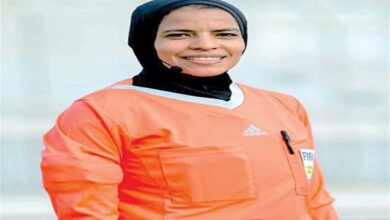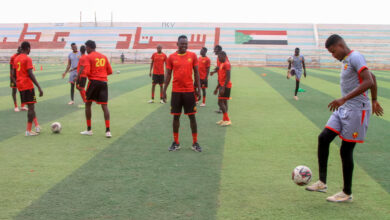The 2010 Egypt Rally kicked off early this morning, with the 15 participating teams driving their cars to the starting point, 30 km outside el-Gouna. The race will take place over two days, with the first phase covering a distance of 160 kilometers. Racers will meet up with their teammates—mainly mechanics and other indispensable assistants—in a camp set up at the end of the day’s course. Adjustments will be made, along with the repairs required for the damage that the cars will inevitably sustain during the first phase of racing.
Along the starting line, EFMS regulators, journalists, and supporters roam around in awe of the metal behemoths, parked in an intimidating row, engines purring ominously. As the racing teams make last minute preparations—hunched over exposed engines or on their backs, poking and probing the underbellies of their vehicles—the crowd of spectators grows, as does the excitement in the air. Drivers and their navigators, or in racing parlance, pilots and co-pilots, zip up their flame-retardant suits, stretch their limbs, and proceed to fraternize with their rivals, offering each other equal amounts of good wishes and playful taunts. Surprisingly, there is no aggression evident between any of the competitors. The way the teams see it, they are a minority united by a common passion, as well as shared experiences—most of which have tested the bounds of their physical, emotional and mental endurance. A band of brothers, motivated more by the overall experience, the joys and tribulations of off-road rally car racing, than by the individual glory of winning.
“In these kinds of races, there are no expectations,” says veteran racer Azzam el-Farouki. Having participated in races using over 26 cars—more impressively, using the same car since 1993—el-Farouki knows what he is talking about. “Your hopes don’t necessarily lie in winning, but in finishing the race. Being able to make the distance, and cross the finish line. You enjoy it, hope for the best.” The soft-spoken speeder, who along with his co-pilot Ahmed Badr race under the name Ecurie Egypt, managed to come in second place in last year’s rally. Today, Ecurie Egypt will begin the race in third place according to the results of the timed track run held yesterday, the purpose of which was to determine the day’s official racing order. Overall, he remains optimistic and enthusiastic about the challenge lying before him. “You do what you can do,” he smiles. “And that’s all you really can do.”
Also participating in this year’s rally is experienced racer Karim el-Zanaty, who at 40 is possessed with more energy than a sugar-crazed preschooler. Between playfully haranguing the other competitors and spectators, el-Zanaty takes a moment to reflect on the day and how he hopes it will turn out. “I’m definitely excited,” he exclaims, literally bouncing on his heels. “This will be a great competition. We have 15 racers, which is unprecedented, and being in this region of the desert means we have some really good, challenging terrain.” El-Zanaty, who has participated in numerous races locally and internationally, including the 7,000 km Dakar rally, is part of the Rally Raid Egypt team, sponsored this year by none other than el-Gouna. “They’ve been really great to us,” nods el-Zanaty . “They’re extremely supportive of sporting events such as this one, and they helped us improve our technology,” he says, gesturing to the team’s three cars parked behind him, by far among the most striking of the gathered vehicles, with their parakeet-bright colors and super sleek designs. El-Zanaty, who came in first place among the diesel-powered cars in 2008’s Rally des Pharaohs, will start today’s race in second place; a fact he is at once proud and wary of. “It has its disadvantages, being in the lead. There’s a lot of pressure to maintain it. You also have to really pay attention to where you’re going. Being behind is difficult because of all the dust stirred up by leading cars, but you can also follow their tracks [to determine where to go or not to go]. Being in the lead means you don’t have that luxury.”
Last to start today’s race is 39-year-old Alexandrian Mohamed el-Antably, who had a bit of bad luck during yesterday’s timed run, critically damaging his car as a result. “We [my team and I] were up till 4am repairing the car,” he smiles grimly. “We had to drive all the way to Hurghada for parts and services needed for the car.” However, el-Antably is not letting that discourage him. “This race consists of that, pretty much—destruction of cars. Not intentional of course, but as a consequence. And in a way, it’s better to be starting off last. If you’re in the lead, you’re constantly stressed out by the possibility of losing that lead. Now, all the way in the end, I’ll be stressing everyone else out,” he laughs.
Joking aside, el-Antably, who currently ranks third place nationally in the diesel powered T2 (lesser-modified cars) category, is well aware of the threats carried in the day’s demands. “It’s vital that you give it [driving] your utmost concentration,” he warns. “You need to know when to speed, and when to slow down. You can’t just try to zip through it, from one end to the other. This will be a challenging course, and full of traps created by the recent floods.”
Also participating in the rally is Italian-Egyptian Gary Garbis, racing in a boldly unique vehicle of his own design. In an attempt to make rally car racing—a somewhat ridiculously expensive sport—more affordable to aspiring racers, Garbis built his car out of an old Volkswagen minibus; the kind “clogging up al-Haram street,” according to the charismatic 46-year-old. Admittedly, while his car lacks the glossy surfaces and dazzling colors of his rivals’ rides, Garbis’ vehicle certainly has a Mad Max-ish charm of its own, looking, for all intents and purposes, like something right out of The Road Warrior.
“I don’t know about winning,” says Garbis, giving his car a look somewhere between affection and uncertainty, “Normally, my first concern in reaching the starting line. That’s the first step. After that, comes ignition. If that works out, then that’s all I can really ask for. Once those two things happen, my mind is at rest.”
Unsurprisingly, Garbis, like el-Antably before him, also has something positive to say about coming in last. “It definitely has its advantages,” he smiles. “I prefer starting last. There’s less pressure. When you start off in the lead, you find yourself suddenly overtaken by a bunch of other cars. That’s just depressing.”
Moments later, through the sudden dim of whistles and horns, organizers pace up and down the line of parked contestants, ordering pilots and co-pilots to prepare for the race, starting momentarily. In a rush, racers pose for a few more pictures, journalists rush around getting last comments, family members embrace their daring loved ones, and everyone clears off as the racers climb into their vehicles. Today, they have a distance of 160 kilometers to cross; tomorrow 239. The race will be challenging, the course full of perils and pitfalls, many of which potentially fatal. Yet, the racers clearly can’t wait to get started. With any luck, their enthusiasm will be carried over, intact for tomorrow’s starting line.
For further updates on the 2010 Egypt Rally Race, including info, pics, and listings of winners, visit this page tomorrow.




